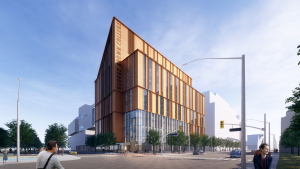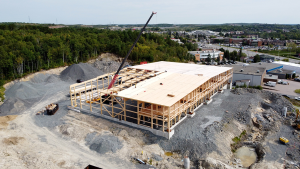The goal of a new research program is to generate technical information that supports the use of mass timber products beyond traditional low-rise construction in tall and large structures.
The Canadian Wood Construction Research Network’s major initiative, the NSERC (Natural Sciences and Engineering Research Council of Canada)-Alliance Grant Next-Generation Wood Construction research program, is being led by principal investigator Prof. Ying Hei Chui of the University of Alberta.
He recently made a presentation at the Society of Fire Protection Engineers Engineering Solutions Symposium in Waterloo, Ont. abut the initiative.
“We actually started the process about two-and-a-half years ago,” said Chui. “I was asked to co-ordinate the discussion and then bring all the researchers together, bring all the industry partners and government partners together to talk about the priority research topics that the industry would like us to undertake, mainly with the objective of supporting the use of mass timber products in large and tall building construction.”
A number of technical and non-technical challenges need to be resolved if mass timber is to be recognized as a mainstream material for tall or large structures, Chui said.
Among the key challenges are gaps in design methodologies and performance data for the next generation of wood buildings; the need to adopt advanced construction engineering tools to capture the benefits of wood construction; inadequate quantification of environmental impacts of wood construction; and a lack of highly qualified personnel (HQP) to meet the needs of this expanded use of wood.
The research program is multi-disciplinary in nature and encompasses a broad range of topics, including structural safety, serviceability, fire safety, energy efficiency, durability and sustainability of wood buildings, as well as the application of advanced construction technologies.
The research projects will be conducted by over 50 HQP who will be supervised by a team of experts, including 31 faculty members from 13 Canadian universities and 20 scientists and professionals from 12 government and industry partners.
The team got funding approval last fall and it took about six months to get organized. The total budget is $6.3 million over five years.
“The majority of them didn’t start until spring or summer of this year, so we’re still early in the process but we plan to have an annual conference with researchers presenting the outcome to the industry,” Chui explained.
Expected impacts are: filling gaps in design standards and building codes – structural, serviceability, fire, thermal and durability; fulfilling the needs of future building code design philosophy such as performance-based, climate-resilient, net-zero carbon; promotion of sustainable off-site construction technologies; quantification of the socio-economic and environmental benefits of wood buildings accounting for entire material supply chain, construction and service phases; and capacity building in support of the wood industry and HQP development
Fire safety and design, prefabrication and modular buildings will be areas of focus.
“Our goal is to generate information that can make influential change to design standards or the building code,” said Chui. “For example, one of the overarching goals of our research is to support the adoption of performance-based design that would be implemented by the National Building Code of Canada.”
He added, “Because mass timber is a relatively new material, what we are trying to do is provide information out there for designers and builders to understand better the performance of the material and maybe eliminate any misconceptions and also fill the gaps in the building code.”
Those interested in participating in the research program as an adviser or collaborator are invited to connect directly with the principal investigators by visiting CWCRN.
“One thing we would like to emphasize is the interaction between the academic researchers and the industry,” Chui said. “We would welcome interest from industry to participate in any of the research project if they’re interested it will make our end results more relevant.”









Recent Comments